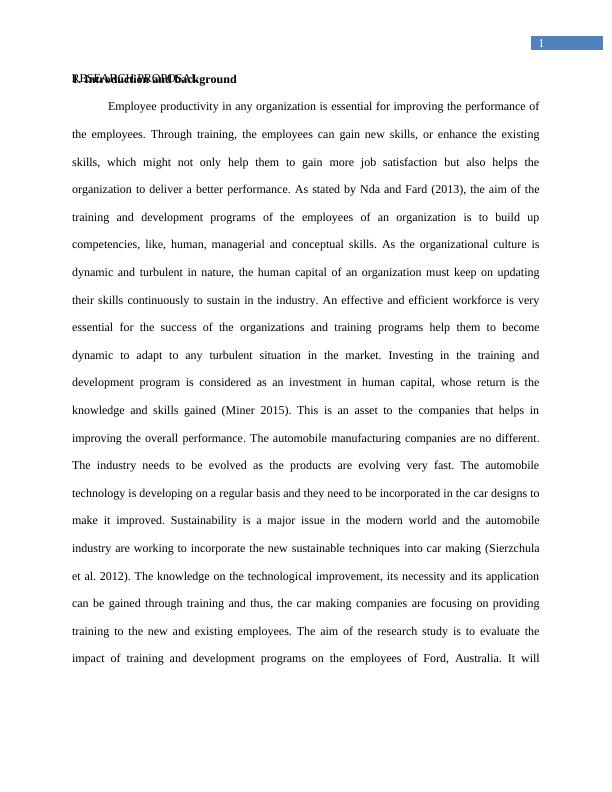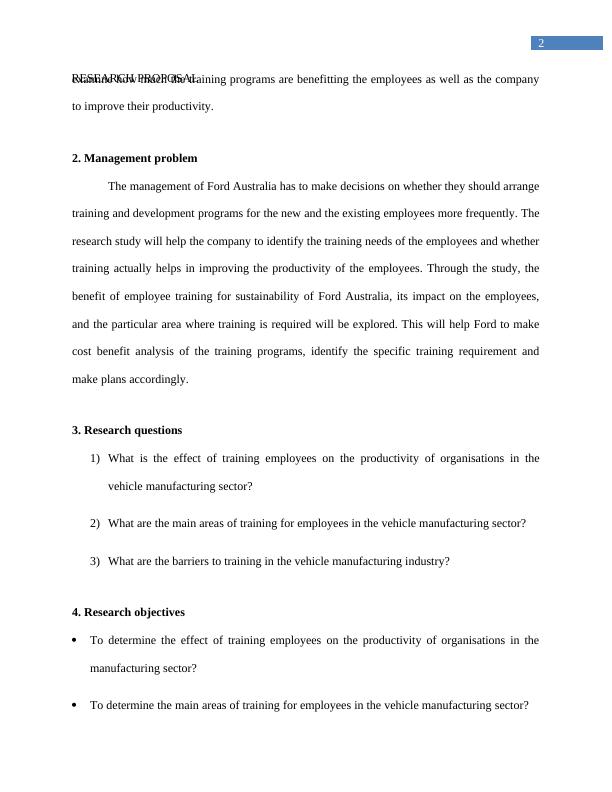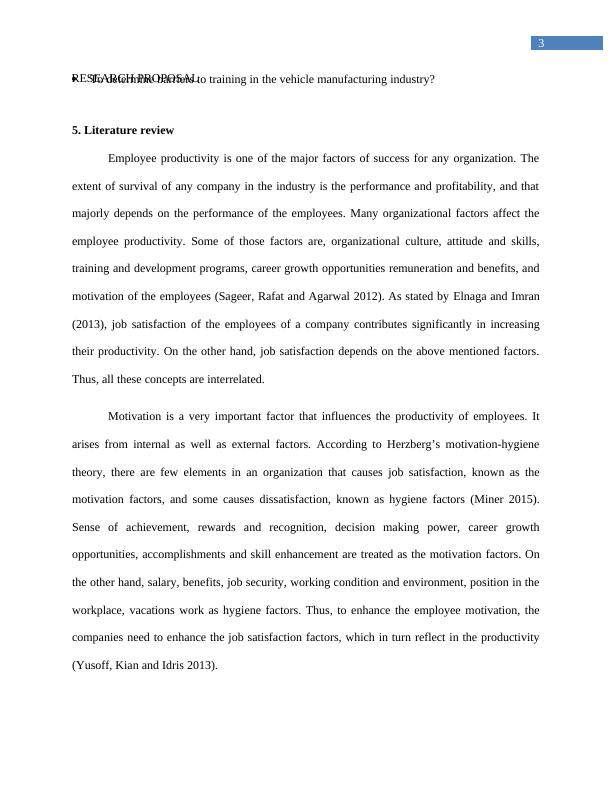Impact of Training on Employee Productivity at Ford Australia
16 Pages3877 Words299 Views
Added on 2021-05-30
Impact of Training on Employee Productivity at Ford Australia
Added on 2021-05-30
ShareRelated Documents
Running head: RESEARCH PROPOSAL Impact of training on employee productivity at Ford AustraliaName of the Student:Name of the University:Author note:

1RESEARCH PROPOSAL1. Introduction and background Employee productivity in any organization is essential for improving the performance ofthe employees. Through training, the employees can gain new skills, or enhance the existingskills, which might not only help them to gain more job satisfaction but also helps theorganization to deliver a better performance. As stated by Nda and Fard (2013), the aim of thetraining and development programs of the employees of an organization is to build upcompetencies, like, human, managerial and conceptual skills. As the organizational culture isdynamic and turbulent in nature, the human capital of an organization must keep on updatingtheir skills continuously to sustain in the industry. An effective and efficient workforce is veryessential for the success of the organizations and training programs help them to becomedynamic to adapt to any turbulent situation in the market. Investing in the training anddevelopment program is considered as an investment in human capital, whose return is theknowledge and skills gained (Miner 2015). This is an asset to the companies that helps inimproving the overall performance. The automobile manufacturing companies are no different.The industry needs to be evolved as the products are evolving very fast. The automobiletechnology is developing on a regular basis and they need to be incorporated in the car designs tomake it improved. Sustainability is a major issue in the modern world and the automobileindustry are working to incorporate the new sustainable techniques into car making (Sierzchulaet al. 2012). The knowledge on the technological improvement, its necessity and its applicationcan be gained through training and thus, the car making companies are focusing on providingtraining to the new and existing employees. The aim of the research study is to evaluate theimpact of training and development programs on the employees of Ford, Australia. It will

2RESEARCH PROPOSALexamine how much the training programs are benefitting the employees as well as the companyto improve their productivity. 2. Management problem The management of Ford Australia has to make decisions on whether they should arrangetraining and development programs for the new and the existing employees more frequently. Theresearch study will help the company to identify the training needs of the employees and whethertraining actually helps in improving the productivity of the employees. Through the study, thebenefit of employee training for sustainability of Ford Australia, its impact on the employees,and the particular area where training is required will be explored. This will help Ford to makecost benefit analysis of the training programs, identify the specific training requirement andmake plans accordingly. 3. Research questions 1)What is the effect of training employees on the productivity of organisations in thevehicle manufacturing sector?2)What are the main areas of training for employees in the vehicle manufacturing sector?3)What are the barriers to training in the vehicle manufacturing industry?4. Research objectives To determine the effect of training employees on the productivity of organisations in themanufacturing sector?To determine the main areas of training for employees in the vehicle manufacturing sector?

3RESEARCH PROPOSALTo determine barriers to training in the vehicle manufacturing industry?5. Literature review Employee productivity is one of the major factors of success for any organization. Theextent of survival of any company in the industry is the performance and profitability, and thatmajorly depends on the performance of the employees. Many organizational factors affect theemployee productivity. Some of those factors are, organizational culture, attitude and skills,training and development programs, career growth opportunities remuneration and benefits, andmotivation of the employees (Sageer, Rafat and Agarwal 2012). As stated by Elnaga and Imran(2013), job satisfaction of the employees of a company contributes significantly in increasingtheir productivity. On the other hand, job satisfaction depends on the above mentioned factors.Thus, all these concepts are interrelated. Motivation is a very important factor that influences the productivity of employees. Itarises from internal as well as external factors. According to Herzberg’s motivation-hygienetheory, there are few elements in an organization that causes job satisfaction, known as themotivation factors, and some causes dissatisfaction, known as hygiene factors (Miner 2015).Sense of achievement, rewards and recognition, decision making power, career growthopportunities, accomplishments and skill enhancement are treated as the motivation factors. Onthe other hand, salary, benefits, job security, working condition and environment, position in theworkplace, vacations work as hygiene factors. Thus, to enhance the employee motivation, thecompanies need to enhance the job satisfaction factors, which in turn reflect in the productivity(Yusoff, Kian and Idris 2013).

End of preview
Want to access all the pages? Upload your documents or become a member.
Related Documents
Origin of Innovation Assignmentlg...
|15
|5219
|327
IT Write Up - Ford Automobile Companylg...
|8
|1251
|325
Developing Skills for Business Leadership Assessmentlg...
|11
|2740
|52
Strategic Solution for Tesla: Research and Development, Production, Human Resources, and Strategylg...
|8
|473
|173
FACILITATE CONTINUOUS IMPROVEMENTlg...
|15
|3705
|46
Basic Principles of Marketing (pdf)lg...
|12
|3559
|22
